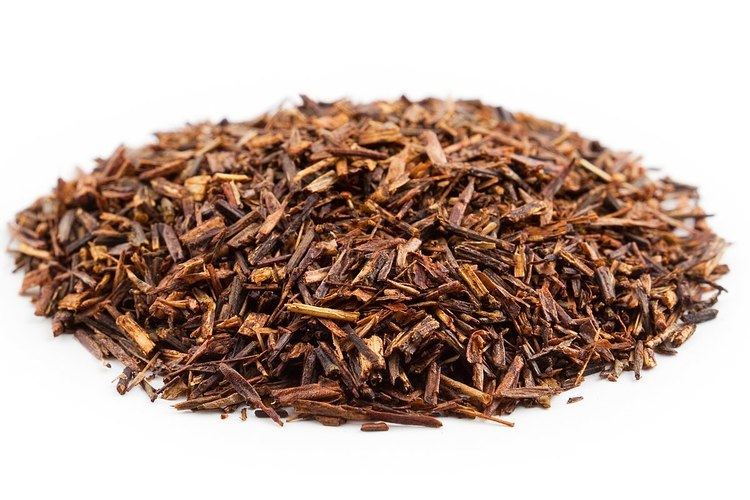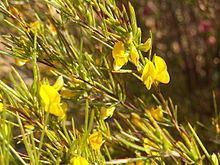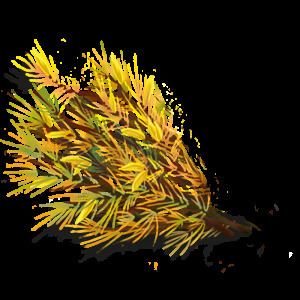Rank Species | Tribe Crotalarieae Higher classification Aspalathus | |
 | ||
Similar Herbal and fruit teas, Oolong, Black tea, Green tea, Masala chai | ||
Rooibos ( /ˈrɔɪbɒs/ ROY-bos; [rɔːibɔs], meaning "red bush"; scientific name Aspalathus linearis) is a broom-like member of the Fabaceae family of plants growing in South Africa's fynbos.
Contents
- Rooibos tea health benefits
- Production and processing
- Use
- Chemical composition
- Grading
- History
- US trademark controversy
- Legal protection of the name rooibos
- Threat from climate change
- References

The generic name comes from the plant Calicotome villosa, aspalathos in Greek, which has very similar growth and flowers to the rooibos plant. The specific name linearis comes from the plant's linear growing structure and needle-like leaves.

The leaves are used to make a herbal tea called rooibos or bush tea (especially in Southern Africa) or sometimes redbush tea (especially in Great Britain). The product has been popular in Southern Africa for generations and is now consumed in many countries. It is sometimes spelled rooibosch in accordance with the old Dutch etymology.

Rooibos tea health benefits
Production and processing

Rooibos is usually grown in the Cederberg, a small mountainous area in the region of the Western Cape province of South Africa.
Generally, the leaves are oxidised (often termed "fermentation" in common tea processing terminology). This process produces the distinctive reddish-brown colour of rooibos and enhances the flavour. Unoxidised "green" rooibos is also produced, but the more demanding production process for green rooibos (similar to the method by which green tea is produced) makes it more expensive than traditional rooibos. It carries a malty and slightly grassy flavour somewhat different from its red counterpart.
Use
In South Africa, rooibos tea is commonly prepared in the same manner as black tea and milk and sugar are added to taste. Other methods include a slice of lemon and using honey instead of sugar to sweeten.
Several coffee shops in South Africa have recently begun to sell rooibos espresso (which is concentrated rooibos served and presented in the style of ordinary espresso). This has given rise to rooibos-based variations of coffee drinks such as rooibos lattes and rooibos cappuccinos.
Iced tea made from rooibos has recently been introduced in South Africa, Germany, Australia, and the United States. A variant of the drink London Fog, known as a Cape Town Fog, can also be made using rooibos steeped in steamed milk with vanilla syrup.
Chemical composition
As a fresh leaf, rooibos has a high content of ascorbic acid (vitamin C).
Rooibos tea does not contain caffeine and has low tannin levels compared to black tea or green tea. Rooibos contains polyphenols, including flavanols, flavones, flavanones, dihydrochalcones, aspalathin and nothofagin.
The processed leaves and stems contain benzoic and cinnamic acids.
Grading
Rooibos grades are largely related to the percentage "needle" or leaf to stem content in the mix. A higher leaf content results in a darker liquor, richer flavour and less "dusty" aftertaste. The high-grade rooibos is exported and does not reach local markets, with major consumers being the EU, particularly Germany, where it is used in creating flavoured blends for loose-leaf tea markets. In development within South Africa are a small number of specialty tea companies producing similar blends.
History
In 1772, Swedish naturalist Carl Thunberg noted, "the country people made tea" from a plant related to rooibos or redbush. Traditionally, the local people would climb the mountains and cut the fine, needle-like leaves from wild rooibos plants. They then rolled the bunches of leaves into hessian bags and brought them down the steep slopes using donkeys. The leaves were then chopped with axes and bruised with hammers, before being left to dry in the sun.
Dutch settlers to the Cape learned to drink rooibos tea as an alternative to black tea, an expensive commodity for the settlers who relied on supply ships from Europe.
In 1904, Benjamin Ginsberg ran a variety of experiments at Rondegat Farm, finally curing rooibos. He simulated the traditional Chinese method of making Keemun by fermenting the tea in barrels. The major hurdle in growing rooibos commercially was that farmers could not germinate the rooibos seeds. The seeds were hard to find and impossible to germinate commercially.
In 1930 District Surgeon and botanist Dr Pieter Le Fras Nortier began conducting experiments with the cultivation of the rooibos plant. Dr Nortier also saw the vast commercial potential the tea held for the region.
Dr Nortier cultivated the first plants at Clanwilliam on his farm Eastside and on the farm Klein Kliphuis. The tiny seeds were very difficult to come by. Dr Nortier paid the local villagers £5 per matchbox of seeds collected. An aged Khoi woman found an unusual seed source: having chanced upon ants dragging seed, she followed them back to their nest and, on breaking it open, found a granary. Dr. Nortier's research was ultimately successful and he subsequently showed all the local farmers how to germinate their own seeds. The secret lay in scarifying the seed pods. Dr Nortier placed a layer of seeds between two mill stones and ground away some of the seed pod wall. Thereafter the seeds were easily propagated. Over the next decade the price of seeds soared to an astounding £80 a pound, the most expensive vegetable seed in the world, as farmers rushed to plant rooibos. Today, the seed is gathered by special sifting processes. Dr Nortier is today accepted as the father of the rooibos tea industry. Thanks to his research, rooibos tea, originally just an indigenous drink, became an iconic national beverage and then a globalised commodity. Rooibos tea production is today the economic mainstay of the Clanwilliam district. In 1948 The University of Stellenbosch awarded Dr Nortier an Honorary Doctorate D.Sc (Agria) in recognition for his valuable contribution to South African agriculture.
US trademark controversy
In 1994, Burke International registered the name "Rooibos" with the US Patent and Trademark Office, thus establishing a monopoly on the name in the United States at a time when it was virtually unknown there. When the plant later entered more widespread use, Burke demanded that companies either pay fees for use of the name, or cease its use. In 2005, the American Herbal Products Association and a number of import companies succeeded in defeating the trademark through petitions and lawsuits; after losing one of the cases, Burke surrendered the name to the public domain.
Legal protection of the name rooibos
The South African Department of Trade and Industry issued final rules on 6 September 2013 that protects and restricts the use of the names "rooibos", "red bush", "rooibostee", "rooibos tea", "rooitee" and "rooibosch" in that country, so that the name cannot be used for things not derived from the Aspalathus linearis plant. It also provides guidance and restrictions for how products which include Rooibos, and in what measures, should use the name "rooibos" in their branding.
Threat from climate change
The rooibos plant is endemic to a small part of the western coast of the Western Cape province of South Africa. It grows in a symbiotic relationship with local micro-organisms and past attempts to grow it outside this area, in places as far afield as the United States, Australia and China, have all failed. Scientists speculate that climate change may threaten the future survival of the plant and the R600-million rooibos industry. Some claim that increasing temperatures and decreasing rainfall may result in the extinction of the plant within the next century.
